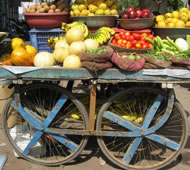Supermarket chains are responsible for an astounding 80% of all grocery sales in the UK, which means there must be entire families who now think all those identical-looking, soil-free carrots and rosy apples on the shelves simply grow or drop off the trees looking that way.
I wanted to know just how we arrive at the supermarkets’ behind-the-scenes ‘written specifications’ that insist on all the vegetables on sale looking cosmetically good and also if these secret conditions imposed on growers would exclude all the crops that fail to meet such exacting aesthetic standards.
In a bid to find out, I tried to speak to growers and packers, many of whom simply clammed up or failed to return my calls. My ‘trigger’ questions, designed to elicit this information from the few who were actually prepared to speak to me, were derived partly from my reading on the topic, but mostly from my experiences working part-time on a small organic farm in Scotland, from my campaigning work on climate change, and from having been an intrigued and frequently bemused supermarket customer.
Whether the model of the shop lighting, the layout, the temperature or even the carefully controlled smells, all facets of supermarket shopping are entirely orchestrated. In the supermarket designers’ own terms, they seek to construct a “‘stage setting’ where we create a mood, an ambience”. As thorough as a theatre set, nothing is accidental: “We lowered the ceilings for intimacy; took the ambience of the local farmers’ market and combined it with the vibrancy and colour of an old-world multi-shop plaza.”
“Discreet high-intensity lighting is used to enhance ‘traditional’ rural values of freshness, quality, nature’s bountifulness and friendliness,” adds another published source intended for supermarket designers. In an amusing discrepancy, the buildings themselves, lavished with all this attention on the inside, are most often ugly, prefabricated shells.
In view of the degree of theatrical control over all aspects of the shopping experience, it’s no surprise that the produce itself should be expected to meet the same rigour and requirements of visual uniformity, and in the layout of the vegetables and in their very appearance you will find a striking absence of any blemish or irregularity.
As uncovered in Joanna Blythman's breathlessly unapologetic Shopped, often the ‘norms’ for vegetables are dictated by the machinery employed to impose this uniformity: oval potatoes, for example, have disappeared because the machine belts cannot handle them without bruising; and whilst supermarket mangoes look and taste like a cross between a stunted honeydew melon and a bendy orange turnip, they have all passed the specification banning sticky bits or brown flecks.
Here is a sample of the cosmetic criteria now prescribed to a tomato producer: products (tomatoes) that must be rejected include those with light scarring or blemishes and those that are ribbed, angular or misshapen. The supermarket buyer will also not accept tomatoes that are at different colour stages in the same box; in fact, photographic colour charts, graded from 1 to 7, are supplied so that the grower can make sure that only produce (tomatoes) matching the 5–7 colour specification is selected.
The required size of the perfect tomato is a circumference of 57–67mm and most supermarket chains agree that the calyx (stalk) should be attached – although this should naturally fall off as the tomato matures. In addition, a total of ten days’ shelf life from packing until the ‘sell by’ date is expected.
“Supermarkets have so much power, but they’re not real,” says one former grower. “They’re not growers or farmers. They’re business. They’re men in suits with white shirts and blue ties. I say to the vegetable buyer, what time of year do you actually drill this crop? Oh, oh, oh, [awkward flap] I don’t know. I just have to buy them. I don’t know.”
From speaking to such producers, it becomes undeniably clear that the journey of the vegetable from soil to supermarket is neither straightforward nor linear. Often growers don’t even sell direct to supermarkets. “We go through a packer who then prepares it,” admits one. Vegetables are collected and gathered up by the packers and redistributed to supermarkets. In other words, the supermarkets have very little to do with the farm.
When I quizzed a swede producer as to how formalised the cosmetic requirements are for swede (probably not a vegetable most treasured for its looks), he replied, “Aesthetic criteria is an actual written contract. You have your contract to supply, and then you have ‘specifications’. You have to produce X to the current specification. Size, colour, taste – everything.” I asked if I could see any of that material. “That’s private and confidential, I’m afraid.”
Once you know that so much of our food production has to be squeezed through fashion whims, you really do begin to notice the lack of soil or anything hinting at an earthy previous life. One farmer who grew for supermarkets in the past outlined a sample of other commonplace cosmetic practices: “If it was potatoes the skin would have to be absolutely clear, the colour good, the shape good, and they would be washed and then packed in polystyrene trays, and then put in peat so it looked as if they had soil. If you go to supermarkets, that’s what you’ll see – peat instead of soil.”
What that means is that even the consolation of the soil to be found on certain batches of supermarket potatoes turns out to be another gimmick of our Disney-fied vegetables. This particular farmer now supplies organic veggie-box schemes, and this serves as a useful point of contrast. “No, the box schemes don’t have the same requirements; they don’t worry so much about cosmetics and are not as demanding,” she says. “We don’t wash any of the vegetables. We believe by selling them with a little soil on they keep their moisture.”
It would have been fascinating to speak to the quality controller or a produce buyer from a supermarket. However, over several weeks of making telephone calls to various departments, all my attempts were fruitless: any snippets of information were classified as confidential. Over and over, I was referred back to their corporate websites – which certainly didn’t display any information about fake soil or any of their other cosmetic expectations of vegetables. I did apply for a job at Asda but got no further than reception and staff canteen!








